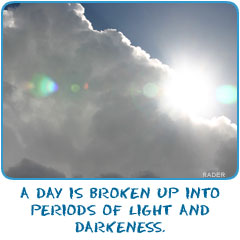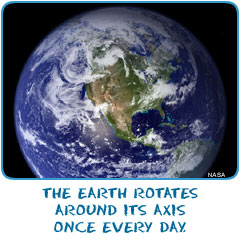Weeks and Weekends
 We've given you scientific and astronomical reasoning for the length of years and days. Do you think we have the same background for weeks? No. Weeks are a bit made up for our society. They are a cultural development. They help when you need to schedule things or to plan, but there is little science involved in the length of a week.
We've given you scientific and astronomical reasoning for the length of years and days. Do you think we have the same background for weeks? No. Weeks are a bit made up for our society. They are a cultural development. They help when you need to schedule things or to plan, but there is little science involved in the length of a week.
There are many origins to a week. Some evidence points to cultures that gathered for market days. There is also a lot of historical evidence that points to religious origins for a week. People used to work for six days and then have one day off to worship. Even today, you will find many religions that choose a day for religious purposes. Depending on the religion, it could be Friday, Saturday, or Sunday. In the modern world, Monday through Friday are work days and Saturday and Sunday are classified as weekends. Office workers do not usually work on the weekends. Speaking of days. What are the days of the week?
Monday
Tuesday
Wednesday
Thursday
Friday
Saturday
Sunday
Weeks and Months
We said there was a little science involved in the length of a week. That little bit is a good coincidence between the length of four weeks and the cycle of the Moon. The Moon goes through a complete cycle (new moon to new moon) about every twenty-eight (28) days. There have been calendars based on 28 day months and there is a good chance that four weeks is about the same length of time. Don't look for many connections between weeks and months in our calendar.
Days and Weeks
You've got months, weeks, and now days. There are seven days in each week. What is a day? Now you can pick up a science book. A day is the time it takes the Earth to make one complete spin or rotation. The Earth rotates around it's axis about once every twenty-four (23.93) hours. Four our convenience, clocks measure days in two blocks of twelve hours. The first twelve hours start at midnight and are labeled as AM. hours. AM. stands for ante meridiem, which is Latin for "before noon." The next twelve hours are labeled PM. PM. stands for post meridiem, which is Latin for "after noon."There are different ways of displaying time that you might hear about. The military uses a different system based on a 24-hour clock. While you might talk about 4 PM for the start of your favorite cartoon, a military man might say, "The cartoon begins at sixteen hundred hours." They count from zero to twenty-four. It's the same for the AM hours, but the PM hours require you to add twelve to the number you see on the clock.
Military Conversion:
Thirteen hundred hours = 1:00 PM
Fourteen hundred hours = 2:00 PM
Fifteen hundred hours = 3:00 PM
Sixteen hundred hours = 4:00 PM
Seventeen hundred hours = 5:00 PM
Eighteen hundred hours = 6:00 PM
Nineteen hundred hours = 7:00 PM
Twenty hundred hours = 8:00 PM
Twenty-one hundred hours = 9:00 PM
Twenty-two hundred hours = 10:00 PM
Twenty-three hundred hours = 11:00 PM
Details to Remember
- There are seven days in a week- There are twenty-four hours in one day.
- Monday (Day 1)
- Tuesday (Day 2)
- Wednesday (Day 3)
- Thursday (Day 4)
- Friday (Day 5)
- Saturday (Day 6)
- Sunday (Day 7)
Related Activities

|
Identifying Times of Day and Night
- Play Activity |

|
Learning the Names of the Days
- Play Activity |
Useful Reference Materials
Wikipedia:https://en.wikipedia.org/wiki/Pre-algebra
Encyclopædia Britannica:
http://www.britannica.com/topic/mathematics
College of the Redwoods:
http://mathrev.redwoods.edu/PreAlgText/





